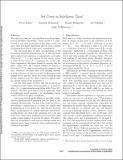Set Cover in Sub-linear Time
Author(s)
Indyk, Piotr; Mahabadi, Sepideh; Rubinfeld, Ronitt; Vakilian, Ali; Yodpinyanee, Anak
DownloadPublished version (609.3Kb)
Publisher Policy
Publisher Policy
Article is made available in accordance with the publisher's policy and may be subject to US copyright law. Please refer to the publisher's site for terms of use.
Terms of use
Metadata
Show full item recordAbstract
© Copyright 2018 by SIAM. We study the classic set cover problem from the perspective of sub-linear algorithms. Given access to a collection of m sets over n elements in the query model, we show that sub-linear algorithms derived from existing techniques have almost tight query complexities. On one hand, first we show an adaptation of the streaming algorithm presented in [17] to the sub-linear query model, that returns an θ-approximate cover using eO (m(n=k)1=(1) + nk) queries to the input, where k denotes the value of a minimum set cover. We then complement this upper bound by proving that for lower values of k, the required number of queries is e(m(n=k)1=(2)), even for estimating the optimal cover size. Moreover, we prove that even checking whether a given collection of sets covers all the elements would require (nk) queries. These two lower bounds provide strong evidence that the upper bound is almost tight for certain values of the parameter k. On the other hand, we show that this bound is not optimal for larger values of the parameter k, as there exists a (1+ϵ)-approximation algorithm with O(mn=kϵ2) queries. We show that this bound is essentially tight for sufficiently small constant ", by establishing a lower bound of e(mn=k) query complexity. Our lower-bound results follow by carefully designing two distributions of instances that are hard to distinguish. In particular, our first lower bound involves a probabilistic construction of a certain set system with a minimum set cover of size k, with the key property that a small number of "almost uniformly distributed" modifications can reduce the minimum set cover size down to k. Thus, these modifications are not detectable unless a large number of queries are asked. We believe that our probabilistic construction technique might find applications to lower bounds for other combinatorial optimization problems.
Date issued
2018-01Department
Massachusetts Institute of Technology. Computer Science and Artificial Intelligence LaboratoryPublisher
Society for Industrial and Applied Mathematics
Citation
Indyk, Piotr, Mahabadi, Sepideh, Rubinfeld, Ronitt, Vakilian, Ali and Yodpinyanee, Anak. 2018. "Set Cover in Sub-linear Time."
Version: Final published version